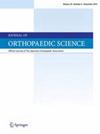早期服用地诺单抗是否会延迟股骨转子间骨折后的骨愈合?
IF 1.5
4区 医学
Q3 ORTHOPEDICS
引用次数: 0
摘要
简介髋部骨折通常与骨质疏松症有关,并构成继发性骨折的风险。虽然建议在骨折后服用抗骨质疏松药物以降低这种风险,但目前尚未广泛研究强效抗骨吸收药物(如地诺苏单抗)对骨折愈合过程的潜在影响。这项前瞻性研究旨在评估股骨转子间骨折手术后早期服用地诺单抗的可行性,并将其对骨折愈合的影响与双膦酸盐治疗患者的影响进行比较:对2018年11月至2020年11月期间接受股骨转子间脆性骨折手术的患者进行前瞻性研究。采用简单的随机化程序将患者随机分为两组(地诺索单抗组 [DSM] 和伊班膦酸钠组 [IBN])。采用体格检查结果、普通X光片和计算机断层扫描(CT)来评估术后3个月的骨折愈合情况:结果:体格检查结果显示,两组患者在负重疼痛、骨折部位触痛或行走能力方面无明显差异。放射学骨折愈合率存在评分者间差异:平片,DSM 组为 57.5%-81.8%,IBN 组为 51.5%-90.9%;CT,DSM 组为 51.5%-72.7%,IBN 组为 45.4%-81.8%。虽然存在差异,但三位评定者在平片或CT上的骨折愈合率在组间无明显差异:结论:与服用伊班膦酸钠相比,股骨转子间骨折手术后早期服用地诺单抗不会延迟放射学或临床骨折愈合时间。本文章由计算机程序翻译,如有差异,请以英文原文为准。
Does early administration of denosumab delay bone healing after intertrochanteric femoral fractures?
Introduction
Hip fractures are commonly associated with osteoporosis and pose a risk for secondary fractures. Although the administration of anti-osteoporotic drugs is recommended after fractures to mitigate this risk, the potential effect of strong anti-resorptive drugs (e.g., denosumab) on fracture healing processes have not been extensively studied. This prospective study aimed to evaluate the feasibility of early denosumab administration after femoral intertrochanteric fracture surgery and to compare its effect on fracture healing to that of bisphosphonate-treated patients.
Materials and methods
Patients who underwent surgery for intertrochanteric femoral fragility fractures between November 2018 and November 2020 were prospectively examined. Patients were randomized into two groups (denosumab [DSM] and ibandronate [IBN] groups) using a simple randomization procedure. Physical findings, plain radiographs, and computed tomography (CT) were used to evaluate fracture healing at 3 months postoperatively.
Results
Physical findings showed no significant differences between the two groups in pain on loading, tenderness at fracture site, or walking ability. There were inter-rater differences in radiological fracture healing rate: plain radiographs, 57.5%–81.8% in the DSM group and 51.5%–90.9% in the IBN group; CT, 51.5%–72.7% in the DSM group and 45.4%–81.8% in the IBN group. Although there were variations, there were no significant differences in the fracture healing rate between groups on plain radiographs or CT among all three raters.
Conclusions
Early administration of denosumab after intertrochanteric femoral fracture surgery did not delay radiological or clinical fracture healing times when compared with ibandronate administration.
求助全文
通过发布文献求助,成功后即可免费获取论文全文。
去求助
来源期刊

Journal of Orthopaedic Science
医学-整形外科
CiteScore
3.00
自引率
0.00%
发文量
290
审稿时长
90 days
期刊介绍:
The Journal of Orthopaedic Science is the official peer-reviewed journal of the Japanese Orthopaedic Association. The journal publishes the latest researches and topical debates in all fields of clinical and experimental orthopaedics, including musculoskeletal medicine, sports medicine, locomotive syndrome, trauma, paediatrics, oncology and biomaterials, as well as basic researches.
 求助内容:
求助内容: 应助结果提醒方式:
应助结果提醒方式:


